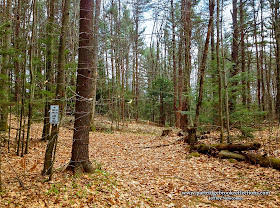
Photographic Treasures in Hillsborough, New Hampshire
It is always exciting to find new places to explore and photograph in my corner of New England. This spring I have discovered the Fox Forest which features a wide variety of New Hampshire habitat. The added bonus is that the forest is located in Hillsborough, New Hampshire which has many other photographic locations, including a famous collection of stone arch bridges and dramatic waterfalls.
The Fox Forest
The Caroline A. Fox Research and Demonstration Forest (Fox Forest) is a 1445 acre demonstration and research forest in
 |
| Fox Forest Headquarters |

In addition to research areas, the Fox Forest offers to visitors 25 miles of trails through a widely a varied ecosystem. Habitats range from peat bogs to virginal forests and oak covered ridges. A marsh on the south side of the forest is the home of Black Gum trees that are estimated to be 400-500 years old. The trails are well marked and accompanied by detailed maps and descriptions of the native treasures.
Early Spring Tour
 I was introduced to Fox Forest early this spring by Kristen Smith of Wicked Dark Photography. On our visit, we explored parts of the north side of the forest down to the Mud Pond. We saw many ferns raising their heads to the sun, but only a few blooms, being a bit early for the best show. We did find a few early blooming Trillium. I am a rank amateur when it comes to plant identification, so it was great to shadow Kristen through the
I was introduced to Fox Forest early this spring by Kristen Smith of Wicked Dark Photography. On our visit, we explored parts of the north side of the forest down to the Mud Pond. We saw many ferns raising their heads to the sun, but only a few blooms, being a bit early for the best show. We did find a few early blooming Trillium. I am a rank amateur when it comes to plant identification, so it was great to shadow Kristen through the  |
| Mud Pond |
 |
| Wicked Dark Photographer |
A Return Visit
On my second visit I followed the Ridge Trail to the Black Gum
 |
| Swamp Trail |
 thing about using a diffuser is to position it as close to the subject as possible without intruding on the frame. This allows the light to softly wrap around the subject. On occasions I was able to use my body to block the light, but this would have worked much better if I had a partner to provide the necessary portable shade. It is always important to watch for distracting backgrounds in macro photographs and this is especially difficult when the backgrounds are
thing about using a diffuser is to position it as close to the subject as possible without intruding on the frame. This allows the light to softly wrap around the subject. On occasions I was able to use my body to block the light, but this would have worked much better if I had a partner to provide the necessary portable shade. It is always important to watch for distracting backgrounds in macro photographs and this is especially difficult when the backgrounds are  |
| White Star |
 |
| Painted Trillium |
Gleason Stone Arch Bridge and Falls
Being in Hillsborough my mind naturally turned to flowing water. The town has a wonderful collection of stone bridges traversing a variety of tumbling brooks. Of these my favorite is the Gleason Bridge which crosses Beard Brook and Gleason Falls. The bridge is a classic dry-laid stone bridge which is held together through the geometry of its stones, without any concrete. Stone arch bridges are always fascinating, but what makes the Gleason Bridge special is that it spans a cascading waterfall.

Given the recent rain, I knew that the waterfall would be dramatic, but as I suspected the bright mid afternoon sunlight was spotlighting the cascades. The brilliant light contrasted starkly with
 |
| Beard Brook |

A beautiful New England forest, a classic stone arch bridge and waterfall, all in all a nice day. I scurried home to upload my pictures and treat my insect bites.
Directions

Fox Forest is located in Hillsborough, New Hampshire
Directions: On Rte. 202/9, take the exit for Hillsborough and Fox Forest. From the lights in the center of Hillsborough, take Center Road northwest about 2 miles to the parking lot on the right at the headquarters of the Caroline A. Fox Research and Demonstration Forest.
Gleason Falls in Hillsborough

Directions: From Route 9, take the exit to Route 202 South for Hillsborough. Take a right on Main Street and then shortly another right onto Beard Road. The road follows Beard Brook north passing one stone bridge on the right which spans the Brook to Jones Road. Continue on Beard Road and a short distance further on the dirt road you will pass over the Gleason Stone Arch Bridge. There is a small turn-off on the right just before the bridge.
Jeffrey Newcomer
Partridgebrookreflections.com

































